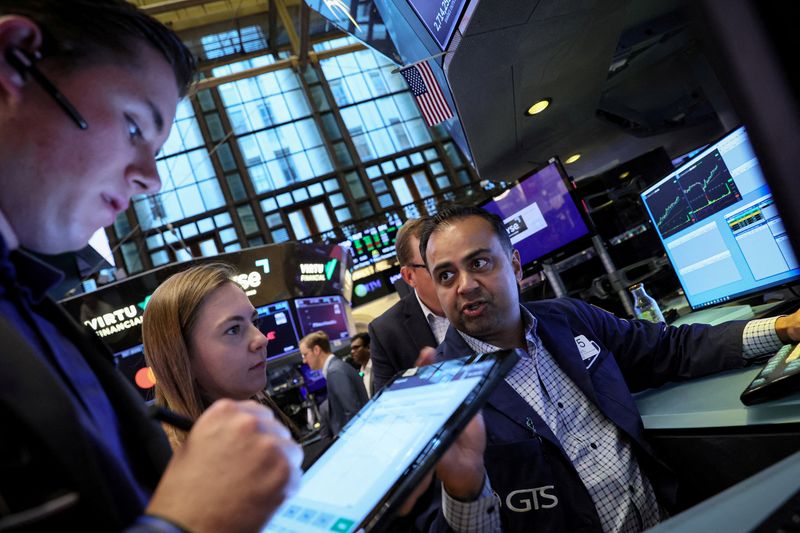Investing.com -- The S&P 500 fell sharply Friday, suffering its worst week since 2023 amid fresh economic worries after data showing the U.S. economy created fewer than expected jobs last month.
By 4:00 p.m. ET (20:00 GMT), the S&P 500 fell 1.7%, taking weekly losses to more than 3% as it notched its worst week since March. The tech-heavy Nasdaq Composite slumped 2.5% and the 30-stock Dow Jones Industrial Average fell 401 points or 1%.
Nonfarm payrolls come in below estimates
The US economy added fewer jobs than anticipated in August, but rose from a sharply revised July figure, according to Labor Department data that could factor into the Federal Reserve's next policy decisions.
Nonfarm payrolls came in at 142,000 last month, up from a heavily downwardly-revised mark of 89,000 in July. Economists had called for a reading of 164,000, up from the initial July mark of 114,000.
Friday's release also showed the US unemployment rate at 4.2%, compared to July's figure of 4.3%. The level was in line with estimates.
On a monthly basis, average hourly earnings growth also ticked up to 0.4% after contracting by 0.1% in July.
"This softness in the labor market is enough to give the Fed cover to ease up on monetary policy, but we do not currently see signs of recession that would necessitate a significant number of cuts," Jefferies said in a note, reiterating its call for the Fed to cut rates by 25 basis point later this month.
Meanwhile, the rate-sensitive 2-year Treasury yield sold off and its 10-year counterpart retraced earlier losses. That contributed to a steepening of the yield curve, which is once again positive. Yields typically move inversely to prices.
Fed's Waller calls for rate cuts to begin
Fed Governor Christopher Waller on Friday called for the U.S. central bank to begging cutting rate later this month, adding that the incoming economic data will determine the size and pace of rate cuts.
"If the data suggests the need for larger cuts, then I will support that as well. I was a big advocate of front-loading rate hikes when inflation accelerated in 2022, and I will be an advocate of front-loading rate cuts if that is appropriate."
The dovish remarks, however, come at a time when the market is already pricing an aggressive rate cutting cycle from the Fed to cushion the economy against a possible slowdown.
"Waller delivers dovish remarks, but markets are already assuming fairly aggressive cutting, and are now worried about growth," Vital Knowledge said in a Friday note, forecasting that a larger 50bps cut for September was now "very likely."
Broadcom sales outlook underwhelms, UiPath turns lower despite beat and raise quarter
Shares in Broadcom (NASDAQ:AVGO) slumped by more than 10% in early US trading after the group's current-quarter sales guidance slightly disappointed investors' expectations. By 10:52 ET (14:52 GMT), shares had dropped 10%.
The firm projected that it would deliver $14 billion in revenue in its fourth quarter, just under estimates of $14.04 billion, according to LSEG data cited by Reuters. The forecast was seen as a sign of possible sluggishness in the company's non-AI-related operations.
The AI segments, however, remained strong, Broadcom said. The firm once again raised its outlook for full-year sales of AI parts and custom chips to $12 billion, up from its prior forecast of more than $11 billion during the period.
Other chip stocks, including artificial intelligence-darling Nvidia (NASDAQ:NVDA) and peer Advanced Micro Devices (NASDAQ:AMD), declined following Broadcom's report. Marvell Technology (NASDAQ:MRVL) and Micron Technology (NASDAQ:MU) were also lower ahead of the opening bell.
UiPath Inc (NYSE:PATH) fell 6% despite raising its annual guidance and reporting Q2 results that beat Wall Street estimates.
Some on Wall Street believe the stock will remain range bound as further signs stable execution is required for investors to turn bullish on the company.
"We continue to believe PATH is likely to remain range-bound over the medium term and await more signs of stable execution," RBC said in a note.
Scott Kanowsky and Reuters contributed to this report.
